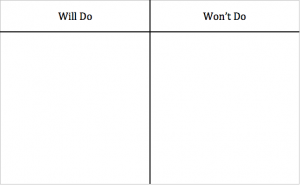At the conclusion of strategic planning with a client this week, one participant expressed tremendous appreciation for having been included. Although not a new employee, she was stunned by how much she had just learned about the company, its leaders, and the challenges and opportunities it faces. She was excited about the profound shift we created, and thankful that she understood the amazing ah-ha’s behind it. What a difference from two years ago when the previous strategic planning never even made a blip on her radar screen!
I’ve heard this too many times to cringe.
And often, the employee is wrong. She may have completely forgotten the strategic planning presentation she attended. But we all know what it’s like to be on the receiving end of such a presentation. It’s like being shown a picture of a tent and then expected to know how to survive in the wilderness.
A well-defined and well-communicated strategy guides daily decisions throughout an organization. Too few organizations achieve an adequate level of strategic clarity to ensure confident and consist decisions even among senior executives, never mind the rest of the employees. The lack of clarity results in delays, wasted time and money, frustration, and a loss of respect for the leaders.
One simple tool for both communicating your strategy as well as engaging employees and testing for understanding is to use a T-chart that looks like this:
After explaining your strategy, give some examples of things that will still be done or will be added, and things that the organization will no longer do. Let employees suggest additional things or ask questions to build the lists. For larger organizations, this process starts at the top. No sense confusing everyone all at once! If top management can’t build this T-chart, they certainly can’t expect others to determine the impact on the next level.
This test for understanding accomplishes three things:
- Employees have the opportunity to explore the impact of the new strategy on their priorities and job responsibilities.
- Managers leading the discussions will discover where they are unclear and will be able to compare charts with each other and their bosses to ensure consist understanding (they should not guess if stymied, but seek clarity themselves and return with better answers).
- The organization will have the opportunity to determine whether they’ve really changed anything. If the “Won’t do” column stays empty, there is a problem. If most employees believe the “Will Do” list is unchanged, there is a problem.



Comments are closed.